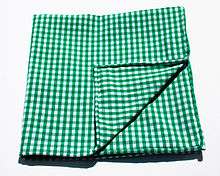Check (pattern)

Cloth of green gingham in check pattern

The original check pattern was the ancient oriental chess-board

A heraldic escutcheon chequy gules and argent

Stylish check patterned Zentai
A check (also checker, Brit: chequer) is a pattern of modified stripes consisting of crossed horizontal and vertical lines forming squares.
Etymology
The word is derived from the ancient Persian language word shah, meaning "king", from the oriental game of chess, played on a squared board, particularly from the expression shah mat, "the king is dead", in modern chess parlance "check-mate". The word entered the French language as echec in the 11th century,[1] thence into English.
Other uses
The check pattern is also used in many areas other than textile styles, for example: on a board used by the mediaeval Exchequer to perform financial computations, and on a board used for playing checkers and chess, and in heraldry.
See also
- Argyle (pattern)
- Battenburg markings
- Checkered flag
- Diapering
- Flannel
- Gingham
- Madras (cloth)
- Plaid (pattern)
- Squared tiling
- Stripe (pattern)
- Tartan
- Tattersall (cloth)
Sources
- Harrison, E.S.; Our Scottish District Checks; National Association of Woollen Manufacturers, Edinburgh; 1968 p6.
References
| Wikimedia Commons has media related to Checkered. |
- ↑ Larousse Dictionnaire de la Langue Francaise, Lexis, Paris, 1993
This article is issued from Wikipedia - version of the 11/19/2016. The text is available under the Creative Commons Attribution/Share Alike but additional terms may apply for the media files.



.svg.png)